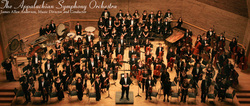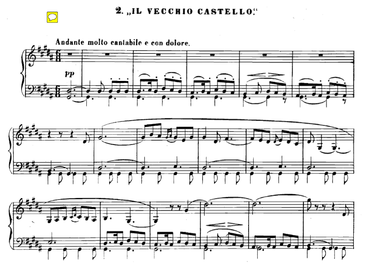
Click the picture to visit the National 4 page created by Education Scotland for all concepts, audio clips and study aids.
Some concepts to get you started!
Tonality - Major/Minor
Step and Leap
Time Signature (no. of beats in the bar)
Volume (Dynamics)– piano (p), mezzo piano(mp), mezzo forte(mf), forte (f)
Speed (Tempo)– adagio, andante, allegro
Homophonic or Polyphonic
Step and Leap
Time Signature (no. of beats in the bar)
Volume (Dynamics)– piano (p), mezzo piano(mp), mezzo forte(mf), forte (f)
Speed (Tempo)– adagio, andante, allegro
Homophonic or Polyphonic
Orchestral Music
Symphony
A symphony is a large scale work for orchestra.
It has no distinct soloist and usually has 4 movements in it. The composer contrasts these by making them fast, slow, lively or reflective. At the end of a symphony there is a coda which is a passage at the end of a piece of music which rounds it off effectively - think of a conclusion in an English essay! Click here to listen to Beethoven's most famous symphony - Symphony No.5 |
Concerto
The concerto is written for soloist and orchestra, e.g. Violin Concerto is for violin and orchestra, Piano Concerto is for piano and orchestra The concerto was often written for virtuoso players – players of a very high technical standard who liked to ‘show-off’ their technical brilliance! The concerto features a cadenza which is a solo passage at the end for the guest performer to show off his/her ability. These can be already written by the composer or completely improvised by the soloist. Click here to listen to Grieg's piano concerto in A minor |
Overture
The overture was originally the orchestra-only curtain-raiser to an opera. The composer would also use it to introduce some of the musical themes (tunes) you would hear in the opera - think of a summary on the back of a book! It is now used for musicals genre as well.
During the 19th century the overture became the ‘concert overture’ – a one movement piece. Click here to listen to the overture from the Sound of Music. See how many themes you can recognise! |
Suite
In music, a suite is an ordered set of instrumental or orchestral pieces normally performed in a concert setting rather than as accompaniment
They may be extracts from an opera, ballet, (Nutcracker Suite) or incidental music to a play (L'Arlésienne Suites) or film (Lieutenant Kije Suite), or they may be entirely original movements (Holberg Suite, The Planets). click here to listen to the march from The Nutcracker Suite. |
Canon
Strict imitation. Once one part starts to play or sing a melody, another part
enters shortly afterwards with exactly the same melody. Frere Jacques is often sung this way. See round - the score is below. Pachelbel's Canon is the most famous canon ever written. It is most often heard at weddings for the bride walking down the aisle.
The piece features a ground bass which is a theme in the bass that is repeated many times while the upper parts are varied. The theme heard over the ground bass takes the form of a variation which is where the melody is heard (the theme) then returns several times with slight changes each time. click here to listen to Pachelbel's Canon. |
Sonata Form
The first movement of a symphony is usually written in sonata form.
It has four sections: Exposition Development Recapitulation Coda There is also a small bridge section which is a linking phrase that connects two sections of music. The beginning is based around a broken chord which is where the notes of a chord are all played separately. Click here to listen to Mozart's Eine Kleine Nachtmusik which begins with a movement in sonata form. |
Solo Instrumental Music
Into this category falls any music composed for a single, unaccompanied instrument. You will find compositions for every conceivable instrument ever invented.
Mozart's Sonata in C K545
This is a piece of music from the Classical era and features a lot of scales and broken chords.
A scale is a sequence of notes moving by step in an ascending or descending order. The broken chords in this piece take two different forms: Alberti Bass and Arpeggios. Alberti Bass
The left hand plays an Alberti Bass which is a bassline that follows a specific pattern (usually using notes 1-5-3-5 in any key) and arpeggios.
|
Arpeggio
An Arpeggio is when you play one note of a chord individually - usually in ascending and descending sequences. Inventing TaskIn Mozart's Sonata in C major, you will hear alot of broken chords in the left hand. You will now invent your own 8 bar broken chord invention in C major using the following chords...
I, ii, IV, V and vi Your teacher will explain these chords to you. |
Bach's Cello Suite No.1
Bach's Cello Suite is also an example of solo instrumental music - written for solo cello.
The performer of the piece is directed to use a term called Rubato which translates as 'robbed time'.This means the music will speed up and slow down in order to allow for expression, therefore a strict tempo will not be maintained. Click here to listen to Bach's Cello Suite No.1. |
Vocal Music

Vocal music is the oldest form of music. Between the 11th and 13th centuries, vocal music developed from a single line of unaccompanied music – Gregorian Chant – into 2 lines of music which moved in exactly the same direction and used exactly the same rhythms (homophonic).
2 parts became 3, then 4 and gradually, over the space of 200 years, becoming more and more independent of each other, the parts weaving in and out of each other at different times using different rhythms. (Accompanying instruments were introduced in the Renaissance period.)
Gregorian Chant - Alleluia Veni Sancte Spiritus
Gregorian chant is some of the earliest form of music sung by monks. it originated in the Medieval period of music. It usually features a single line melody and is usually homophonic.
This piece features a lot of melisma which is several notes sung to one syllable. Click here to listen to this example of Gregorian chant. |
Palestrina - Missa Papae Marcelli - Gloria
This piece of music is from the Renaissance music era and differs from gregorian chant in more than one way.
This piece features a syllabic word setting which means there is one note sung for every syllable. click here to listen to this piece by Palestrina |
John Taverner - The Lamb
This is a piece written in the 20th century era of music.
It is homophonic in texture and features unison and harmony. Click here to listen to "The Lamb" |
ComparisonCompare all three pieces in groups. Discuss and write down what elements of the pieces are the same and what are different. |
Opera
Musical Eras
Baroque
Baroque is the name given to a style of music composed during a particular
period, 1600-1750 approximately. Bach and Handel are two of the composers from this period. The Harpsichord was a very popular keyboard instrument at this time. Listen to the harpsichord being played here. |
Romantic Period
In music, the period 1810-1900 approximately, which followed the Classical era.
The Romantic orchestra grew in size and added piccolo, trombone and more varied percussion. Berlioz, Chopin and Liszt are composers from the Romantic Period. |
Ternary Form
This is when you have a piece of music with the following structure:
Section A - Section B - Section A (again) |
Imitation
Where the melody is immediately copied in another part. It need not be an exact
copy. |
Pedal PIctures at an Exhibition by Mussorgsky
Short for pedal point. A note which is sustained, or repeated continuously, in
the bass beneath changing harmonies. In this movment from PIctures at an Exhibition by Mussorgsky you can hear the G# being played in the left hand of the piano part all the way through. |
Inverted Pedal
A note which is held on or repeated continuously at a high pitch. Opposite in pitch to pedal. This device is often used by composers to create a sense of tension within the music. Listen to the finale of Dmitri Shostakovich's 5th Symphony to hear the inverted pedal in the upper strings and woodwind!
Click here to see a live score with the recording on the San Francisco Symphony Orchestra's website on Shostakovich! |


